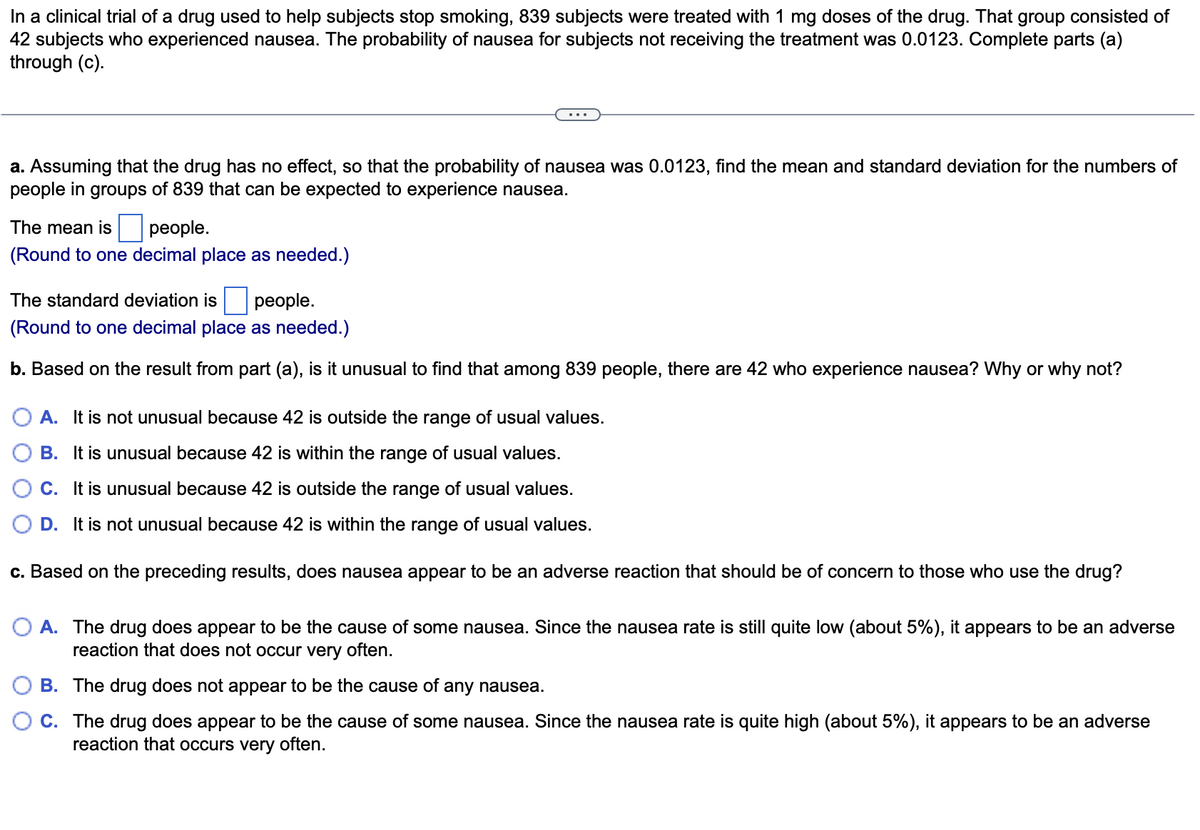uming that the drug has no effect, so that the probab in groups of 839 that can be expected to experience ean is people. I to one decimal place as needed.) andard deviation is реople.
uming that the drug has no effect, so that the probab in groups of 839 that can be expected to experience ean is people. I to one decimal place as needed.) andard deviation is реople.
Glencoe Algebra 1, Student Edition, 9780079039897, 0079039898, 2018
18th Edition
ISBN:9780079039897
Author:Carter
Publisher:Carter
Chapter10: Statistics
Section10.4: Distributions Of Data
Problem 19PFA
Related questions
Question

Transcribed Image Text:In a clinical trial of a drug used to help subjects stop smoking, 839 subjects were treated with 1 mg doses of the drug. That group consisted of
42 subjects who experienced nausea. The probability of nausea for subjects not receiving the treatment was 0.0123. Complete parts (a)
through (c).
a. Assuming that the drug has no effect, so that the probability of nausea was 0.0123, find the mean and standard deviation for the numbers of
people in groups of 839 that can be expected to experience nausea.
The mean is
реople.
(Round to one decimal place as needed.)
The standard deviation is
реople.
(Round to one decimal place as needed.)
b. Based on the result from part (a), is it unusual to find that among 839 people, there are 42 who experience nausea? Why or why not?
A. It is not unusual because 42 is outside the range of usual values.
B. It is unusual because 42 is within the range of usual values.
C. It is unusual because 42 is outside the range of usual values.
O D. It is not unusual because 42 is within the range of usual values.
c. Based on the preceding results, does nausea appear to be an adverse reaction that should be of concern to those who use the drug?
O A. The drug does appear to be the cause of some nausea. Since the nausea rate is still quite low (about 5%), it appears to be an adverse
reaction that does not occur very often.
B. The drug does not appear to be the cause of any nausea.
O C. The drug does appear to be the cause of some nausea. Since the nausea rate is quite high (about 5%), it appears to be an adverse
reaction that occurs very often.
Expert Solution
This question has been solved!
Explore an expertly crafted, step-by-step solution for a thorough understanding of key concepts.
Step by step
Solved in 2 steps

Recommended textbooks for you

Glencoe Algebra 1, Student Edition, 9780079039897…
Algebra
ISBN:
9780079039897
Author:
Carter
Publisher:
McGraw Hill

Glencoe Algebra 1, Student Edition, 9780079039897…
Algebra
ISBN:
9780079039897
Author:
Carter
Publisher:
McGraw Hill